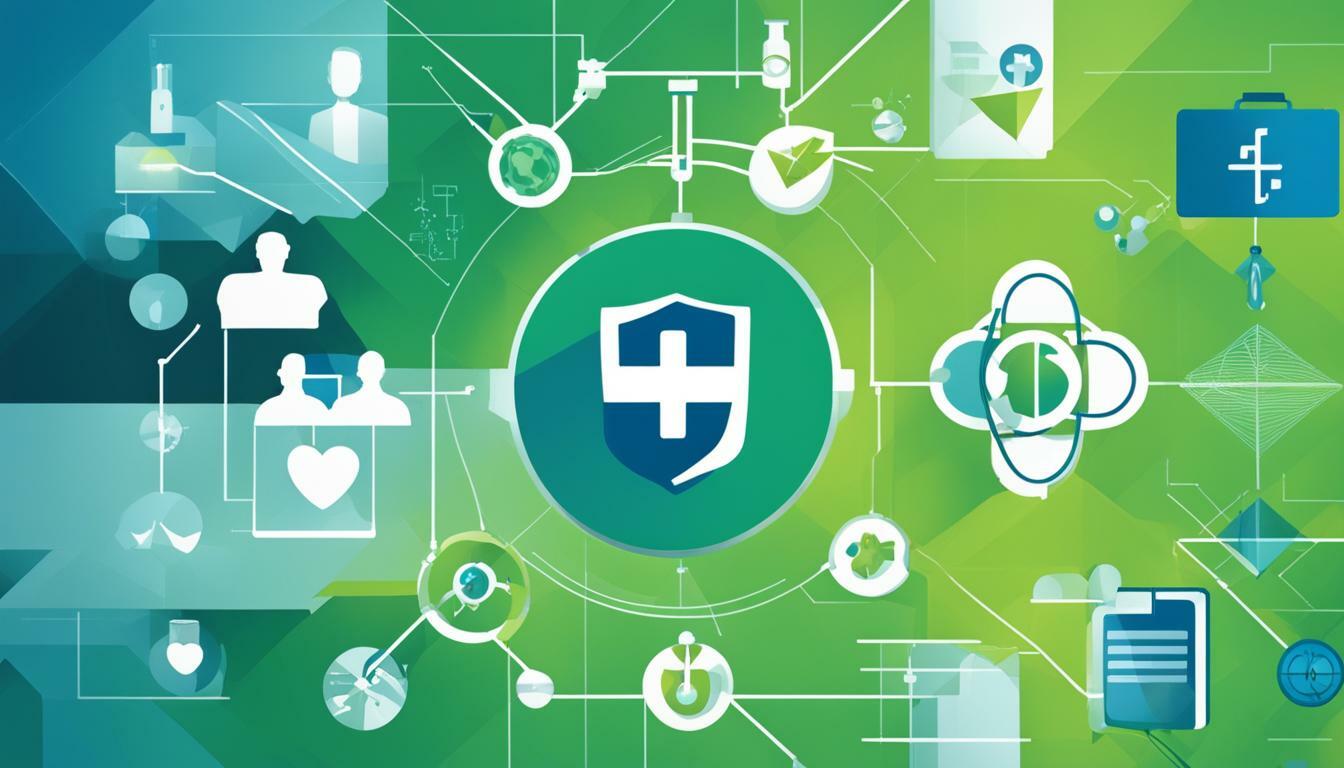
The doctor industry is experiencing significant changes driven by the COVID-19 pandemic and technological advancements. From the impact of the pandemic to the transformative role of technology, these trends are shaping the future of healthcare. In this article, I will delve into the latest insights and developments that are shaping the doctor industry in the United States.
- The COVID-19 pandemic has accelerated the adoption of telehealth, offering convenient and cost-effective virtual doctor visits.
- Integrated medical technologies, such as electronic health records and wearable devices, are revolutionizing communication between healthcare providers and patients.
- The Affordable Care Act has expanded access to insurance and improved coverage, particularly for vulnerable groups.
- The future of healthcare will be shaped by AI, data-driven personalized care, and the impact of climate change on healthcare delivery.
- Supply chain management and collaboration with non-healthcare companies are emerging trends for efficient healthcare delivery.
The Growing Importance of Telehealth in the Doctor Industry
Telehealth has become increasingly prevalent in the doctor industry, revolutionizing the way patients access medical care. This trend has been accelerated by the COVID-19 pandemic, which has highlighted the need for alternative healthcare delivery methods. With virtual doctor visits, patients can receive timely medical consultations and treatment from the comfort of their own homes.
One of the key benefits of telehealth is its convenience. Patients no longer have to travel to a physical clinic or wait in crowded waiting rooms. Instead, they can simply schedule an appointment and connect with their healthcare provider through secure video conferencing platforms. This not only saves time and money but also reduces the risk of exposure to contagious diseases.
Furthermore, telehealth has proven to be a cost-effective solution in the healthcare industry. By minimizing the need for in-person consultations, it reduces expenses related to infrastructure, staff, and equipment. This makes healthcare more accessible to individuals who may have limited financial resources or live in remote areas with limited access to medical facilities.
In addition to convenience and cost-effectiveness, telehealth also offers the potential for improved healthcare outcomes. Through remote monitoring and the use of wearable devices, doctors can collect and analyze real-time patient data, enabling more accurate diagnoses and personalized treatment plans. This integrated medical technology enhances communication between healthcare providers and patients, leading to better overall health management.
The Benefits and Challenges of Telehealth
While the benefits of telehealth are evident, there are also challenges that need to be addressed. One of the main concerns is the potential for a lack of physical examination. Although telehealth enables doctors to assess patients remotely, certain conditions may require in-person examinations for accurate diagnosis and treatment.
Moreover, there are disparities in access to technology and internet connectivity, particularly in underserved communities. This digital divide poses a barrier to telehealth adoption for some individuals, limiting their ability to benefit from virtual doctor visits.
Despite these challenges, telehealth is here to stay. As we continue to adapt to the evolving healthcare landscape, telehealth will play an increasingly important role in providing accessible and efficient medical care to patients across the United States and beyond.

| Benefits of Telehealth | Challenges of Telehealth |
|---|---|
|
|
The Role of Integrated Medical Technologies in Healthcare Communication
The integration of medical technologies has revolutionized the way doctors communicate with patients, leading to enhanced healthcare experiences. In today’s digital age, electronic health records (EHRs) have become a cornerstone of healthcare communication. With the ability to store and access patient information securely, EHRs enable healthcare providers to make more informed decisions, streamline workflows, and improve patient outcomes.
Wearable devices have also emerged as valuable tools in healthcare communication. These devices, such as fitness trackers and smartwatches, can continuously monitor patients’ vital signs and provide real-time data to healthcare professionals. This allows for remote patient monitoring and early detection of potential health issues, ultimately leading to more proactive and personalized care.
“EHRs enable healthcare providers to make more informed decisions, streamline workflows, and improve patient outcomes.”
Furthermore, the integration of medical technologies has paved the way for improved collaboration between healthcare providers. Through secure platforms and networks, doctors can easily share patient information, test results, and treatment plans with specialists, ensuring a comprehensive approach to care. This collaborative environment promotes knowledge-sharing and enables healthcare teams to work together seamlessly, ultimately benefiting patients.
To summarize, the integration of medical technologies, including electronic health records and wearable devices, has transformed the way doctors communicate with patients. By leveraging these tools, healthcare providers can access and share crucial patient information, monitor health remotely, and collaborate effectively with other professionals. This technology-driven approach to healthcare communication is revolutionizing the industry and is set to shape the future of patient care.

The Affordable Care Act has brought about significant changes in the doctor industry, enabling greater access to healthcare services for millions of Americans. As a result of the Act, insurance coverage has expanded, making healthcare more affordable and accessible for vulnerable groups. This has had a profound impact on the doctor industry, as more individuals now have the ability to seek timely medical care without financial barriers.
One of the key provisions of the Affordable Care Act is the expansion of Medicaid, a government program that provides health coverage for low-income individuals and families. This expansion has allowed millions of previously uninsured Americans to gain access to comprehensive healthcare services, including doctor visits, prescription medications, and preventive care. By ensuring that more individuals have insurance coverage, the Act has helped to improve health outcomes and reduce healthcare disparities.
Furthermore, the Affordable Care Act has introduced essential health benefits, which include coverage for essential services such as doctor visits, hospital stays, and preventive care. These benefits ensure that individuals have access to comprehensive healthcare services, regardless of their pre-existing conditions or income level. This has been particularly beneficial for vulnerable groups, such as those with chronic illnesses or disabilities, who previously faced difficulties in obtaining adequate healthcare coverage.
| Key Provisions of the Affordable Care Act | Impact on the Doctor Industry |
|---|---|
| Expansion of Medicaid | Increased access to healthcare services for low-income individuals |
| Essential health benefits | Improved coverage for preventive care and essential services |
| Protection for individuals with pre-existing conditions | Ensured access to healthcare services without discrimination |
The Affordable Care Act has been instrumental in expanding access to healthcare services and improving coverage for vulnerable populations. It has enabled millions of Americans to seek timely medical care without the fear of financial burdens. This has not only improved health outcomes but also reduced healthcare disparities across the country.
Looking ahead, the doctor industry will continue to adapt to the changing landscape of healthcare, driven by the Affordable Care Act and other emerging trends. It is crucial for healthcare organizations and policymakers to recognize the importance of ensuring access to quality care for all individuals, particularly vulnerable groups. By addressing the barriers to healthcare access and coverage, we can work towards a healthcare system that is equitable and inclusive.

Shaping the Future of Healthcare: AI, Data-Driven Care, and Climate Change
The future of healthcare holds exciting prospects with the integration of AI, data-driven care, and the need to address the impact of climate change on the doctor industry. As technology continues to advance, artificial intelligence (AI) is poised to revolutionize healthcare delivery. AI-powered systems can analyze vast amounts of medical data, identify patterns, and provide valuable insights to support diagnosis and personalized treatment plans.
Data-driven care is another key aspect of the future of healthcare. With the increasing availability of electronic health records and wearable devices, healthcare providers can access real-time patient data, enabling more accurate and informed decision-making. This data-driven approach allows for personalized care that takes into consideration the unique needs and circumstances of each individual.
Climate change is a pressing global challenge that will have significant implications for the healthcare industry. Rising temperatures, extreme weather events, and changes in disease patterns will require healthcare organizations to adapt their practices to ensure the safety and well-being of patients. This includes implementing sustainable infrastructure, developing emergency response plans, and promoting public health initiatives to mitigate the impact of climate change.
| Key Trends in the Future of Healthcare |
|---|
| Integration of AI in healthcare delivery |
| Data-driven personalized care |
| Addressing the impact of climate change on healthcare |
As we navigate the ever-evolving landscape of healthcare, it is crucial for healthcare organizations to stay informed and adapt to these trends. Embracing AI and data-driven care can lead to improved patient outcomes and enhanced efficiency in healthcare delivery. By addressing the impact of climate change, healthcare providers can ensure the ongoing provision of quality care even in challenging environmental conditions.

As we look to the future, it is clear that the doctor industry will continue to evolve and transform. By harnessing the power of AI, embracing data-driven care, and taking proactive steps to address climate change, healthcare organizations can pave the way for a more efficient, personalized, and sustainable healthcare system.
Key Trends to Watch: Supply Chain Management, Collaboration, and Patient Engagement
As the doctor industry evolves, supply chain management, collaboration, and patient engagement are pivotal trends to watch for enhanced healthcare outcomes and patient satisfaction.
Efficient supply chain management is crucial for ensuring the availability of essential medical supplies and equipment. The COVID-19 pandemic has demonstrated the importance of a resilient and adaptable supply chain to meet the increased demand for healthcare resources. Healthcare organizations are increasingly leveraging technology and data analytics to optimize inventory management, streamline procurement processes, and enhance logistics. By implementing robust supply chain strategies, healthcare providers can reduce costs and mitigate risks, ultimately improving patient care.
Collaboration among healthcare stakeholders is essential for delivering comprehensive and coordinated care. In an increasingly interconnected healthcare landscape, collaboration between hospitals, clinics, pharmacies, and other healthcare providers is vital to ensure seamless transitions of care. By sharing patient information, collaborating on treatment plans, and leveraging collective expertise, healthcare professionals can deliver more efficient and effective care. Additionally, collaboration with non-healthcare companies, such as technology providers and innovators, can bring fresh perspectives and solutions to address complex healthcare challenges.
Patient engagement is a critical aspect of delivering patient-centered care and improving health outcomes. By actively involving patients in their own care, healthcare providers can promote shared decision-making, enhance treatment adherence, and increase patient satisfaction. Advanced technologies, such as patient portals and mobile health applications, enable patients to access their medical records, communicate with healthcare professionals, and actively participate in managing their health. Additionally, personalized care, tailored to individual patient needs and preferences, can foster a deeper level of engagement and ultimately lead to better healthcare outcomes.
As healthcare continues to evolve, supply chain management, collaboration, and patient engagement will remain key focus areas for healthcare organizations. By embracing these trends, healthcare providers can optimize resource utilization, improve care coordination, and empower patients to actively participate in their healthcare journey. As we look to the future, it is crucial for the doctor industry to adapt and innovate in order to deliver high-quality, patient-centered care.
FAQ
What are the latest trends shaping the doctor industry in the United States?
The latest trends in the doctor industry include the impact of the COVID-19 pandemic, the transformative role of technology, and the expansion of access to insurance through the Affordable Care Act.
How has telehealth become important in the doctor industry?
Telehealth has become vital in the doctor industry as it offers a convenient and cost-effective solution for virtual doctor visits, allowing patients to receive medical care remotely.
What is the role of integrated medical technologies in healthcare communication?
Integrated medical technologies, such as electronic health records and wearable devices, are improving communication between healthcare providers and patients, leading to better healthcare outcomes.
How has the Affordable Care Act impacted access and coverage in the doctor industry?
The Affordable Care Act has expanded access to insurance and improved coverage, particularly for vulnerable populations, making healthcare more accessible for millions of Americans.
How will the future of healthcare be shaped by AI, data-driven care, and climate change?
The future of healthcare will be influenced by the increasing use of artificial intelligence and data-driven personalized care, as well as the need to address the impact of climate change on healthcare delivery.
What are the key trends to watch in the doctor industry?
Key trends to watch include supply chain management, collaboration with non-healthcare companies, patient engagement, and the consumerization and personalization of healthcare services.



